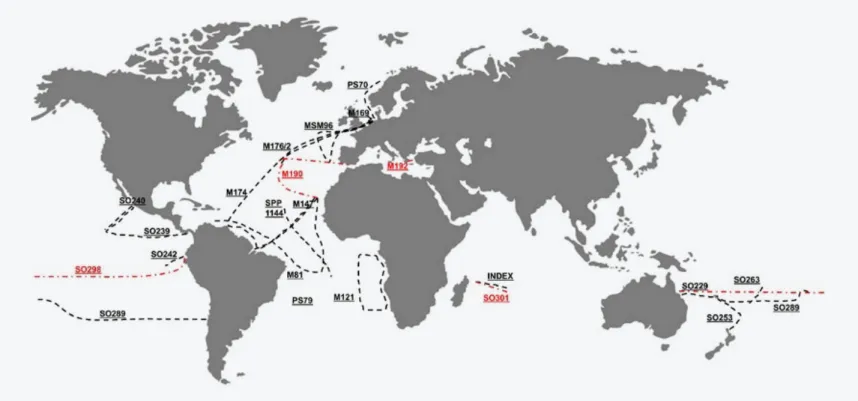Geochemistry of Trace Metals in the Ocean
Group leader
Specific themes and goals
- Hydrothermal research: Submarine hydrothermal activity is the principal mechanism that controls the transfer of heat and chemicals at the ocean/crust interface. At the seafloor, this process manifests as spectacular black smokers, where high-temperature, metal-rich, anoxic and acidic fluids are emitted into the cold, oxygen-rich bottom waters of the oceans. The strong physico-chemical gradients lead to the precipitation of metals that form the black smoke as well as the chimney structures from which the fluids are venting. However, the hydrothermal plume can transport trace-metals over large distances and contribute to the elemental budget of the ocean.
- The GEOTRACES programme: For more than 40 years, scientists around that world have participated in a joint effort to study the distribution, sources, and sinks of trace metals and their isotopes in different oceanic settings. Koschinsky’s group has been part of this programme for more than 10 years and provided the first data set of rare metals such as niobium (Nb), a trace metal of which very little is known, to this database.
- Estuary research: The large Amazon and Pará Rivers converge in the Amazon-Pará River estuary. As a result of their enormous water volumes, these rivers are a major source of trace metals, nutrients and organic matter. We determined, for the first time, the fluxes and distributions of transition metals such as iron, cobalt, nickel and lead in the Amazon-Pará River estuary. We also conducted cruise M169 in the North Sea, and specifically investigated the estuaries of three German rivers (the Weser, Ems, and Elbe). We focused on the input of critical metals used in new technologies and medicine into coastal waters.
- Environmental impact of deep-sea mining: The MiningImpact 2 project, part of the EU programme JPI Oceans, studies the environmental impacts and risks of mining ferromanganese nodules in the deep-ocean basins. We assessed the release of potentially toxic metals during mining operations. After the test mining of a nodule collector prototype, the upcoming cruise SO295 will revisit the disturbed area after more than a year to investigate the environmental impact and recovery processes.
Highlights and impact
- The Northeast Lau Basin is an area affected by widespread hydrothermal activity, but little was known about the geochemistry of high-temperature hydrothermal fluids venting in a number of places. Based on research cruise SO263, we reported the first vent fluid data for Maka volcano and Niuatahi volcano, describing the processes that affect the vent fluid composition.
- Our recent Amazon estuary workshop highlighted the global relevance of this large land-ocean interface in times of climate change and participants started planning an upcoming followup cruise in the Amazon estuary during the dry season.
- The team looks forward to four exciting research cruises taking place in 2023 in the Central Pacific (SO298), northern Atlantic (M190), Mediterranean (M192) and Indian Ocean (SO301) in collaboration with partners from GEOMAR, MARUM, and others. The focus will be on hydrothermal systems and GEOTRACES-related topics.
Group composition & projects/funding
The marine geochemistry group with a focus on trace metals consists of a diverse team, which currently includes four PhD students, three postdoctoral researchers, and a lab technician as well as two visiting scholars. Many former group members are still affiliated with our team as guest scientists or collaboration partners. Personnel and research projects are funded through several grants from the German Science Foundation (DFG) and the Federal Ministry for Education and Research (BMBF), as well as some scholarships.
Selected publications
- Kurahashi, E., Poehle, S. and Koschinsky, A., 2024. Determination of vanadium redox species V (IV) and V (V) in seawater using chelating resin and inductively coupled plasma mass spectrometry. Deep Sea Research Part I: Oceanographic Research Papers, p.104261. https://doi.org/10.1016/j.dsr.2024.104261
- Paul, S. A. L.; Zitoun, R.; Noowong, A.; Manirajah, M. and Koschinsky A. (2021) Copper-binding ligands in deep-sea pore waters of the Pacific Ocean and potential impacts of polymetallic nodule mining on the copper cycle. Scientific reports 11: 18425. https://doi.org/10.1038/s41598-021-97813-3
- Koschinsky, A., Schmidt, K. and Garbe-Schönberg, D. (2020): Geochemical time series of hydrothermal fluids from the slow-spreading Mid-Atlantic Ridge: Implications of medium-term stability. Chemical Geology, 552. 10.1016/j.chemgeo.2020.119760
- Koschinsky, A., Hein, J.R., Kraemer, D., Foster, A.L., Kuhn, T., Halbach, P. (2020): Platinum enrichment and phase associations in marine ferromanganese crusts and nodules based on a multi-method approach. Chemical Geology 539. 10.1016/j.chemgeo.2019.119426
- Kleint, C., Bach, W., Diehl, A., Fröhberg, N., Garbe-Schönberg, D., Hartmann, J.F., de Ronde, C.E.J., Sander, S.G., Strauss, H., Stucker, V., Thal, J., Zitoun, R. and Koschinsky, A. (2019): Geochemical characterization of highly diverse hydrothermal fluids from volcanic vent systems of the Kermadec intraoceanic arc, Chemical Geology 528. 10.1016/j.chemgeo.2019.119289

